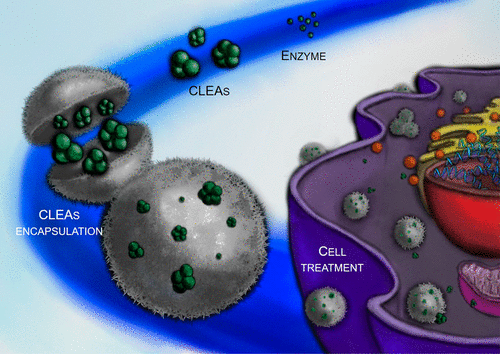当前位置:
X-MOL 学术
›
Bioconjugate Chem.
›
论文详情
Our official English website, www.x-mol.net, welcomes your
feedback! (Note: you will need to create a separate account there.)
Cross-Linked Enzyme Aggregates as Versatile Tool for Enzyme Delivery: Application to Polymeric Nanoparticles
Bioconjugate Chemistry ( IF 4.0 ) Pub Date : 2018-06-12 00:00:00 , DOI: 10.1021/acs.bioconjchem.8b00206 Marianna Galliani 1, 2 , Melissa Santi 1, 2 , Ambra Del Grosso 2 , Antonella Cecchettini 3, 4 , Filippo Maria Santorelli 5 , Sandra L Hofmann 6 , Jui-Yun Lu 6 , Lucia Angella 2 , Marco Cecchini 2 , Giovanni Signore 1, 2
Bioconjugate Chemistry ( IF 4.0 ) Pub Date : 2018-06-12 00:00:00 , DOI: 10.1021/acs.bioconjchem.8b00206 Marianna Galliani 1, 2 , Melissa Santi 1, 2 , Ambra Del Grosso 2 , Antonella Cecchettini 3, 4 , Filippo Maria Santorelli 5 , Sandra L Hofmann 6 , Jui-Yun Lu 6 , Lucia Angella 2 , Marco Cecchini 2 , Giovanni Signore 1, 2
Affiliation

|
Polymeric nanoparticles (NPs) represent one of the most promising tools in nanomedicine and have been extensively studied for the delivery of water-insoluble drugs. However, the efficient loading of therapeutic enzymes and proteins in polymer-based nanostructures remains an open challenge. Here, we report a synthesis method for a new enzyme delivery system based on cross-linked enzyme aggregates (CLEAs) encapsulation into poly(lactide-co-glycolide) (PLGA) NPs. We tested the encapsulation strategy on four enzymes currently investigated for enzyme replacement therapy: palmitoyl protein thioesterase 1 (PPT1; defective in NCL1 disease), galactosylceramidase (GALC; defective in globoid cell leukodystrophy), alpha glucosidase (aGLU; defective in Pompe disease), and beta glucosidase (bGLU; defective in Gaucher’s disease). We demonstrated that our system allows encapsulation of enzymes with excellent activity retention (usually around 60%), thus leading to functional and targeted nanostructures suitable for enzyme delivery. We then demonstrated that CLEA NPs efficiently deliver PPT1 in cultured cells, with almost complete enzyme release occurring in 48 h. Finally, we demonstrated that enzymatic activity is fully recovered in primary NCL1 fibroblasts upon treatment with PPT1 CLEA NPs.
中文翻译:

交联的酶聚集体作为酶传递的多功能工具:应用于聚合物纳米粒子。
聚合物纳米颗粒(NPs)代表了纳米医学中最有前途的工具之一,并且已经广泛研究了水不溶性药物的递送。然而,在基于聚合物的纳米结构中有效装载治疗性酶和蛋白质仍然是一个开放的挑战。这里,我们报告了基于交联的酶聚集体(CLEA)封装成聚一个新的酶输送系统的合成方法(丙交酯-共-乙交酯(PLGA)NPs。我们测试了目前用于酶替代疗法的四种酶的包封策略:棕榈酰蛋白硫酯酶1(PPT1;在NCL1疾病中有缺陷),半乳糖苷神经酰胺酶(GALC;在球状细胞白细胞营养不良中有缺陷),α葡萄糖苷酶(aGLU;在Pompe病中有缺陷),和β葡萄糖苷酶(bGLU;在高雪氏病中有缺陷)。我们证明了我们的系统可以使酶具有出色的活性保留率(通常为60%左右),从而产生适合酶递送的功能性和靶向性纳米结构。然后,我们证明了CLEA NP在培养的细胞中有效地递送了PPT1,并且在48小时内几乎完全释放了酶。最后,我们证明了在用PPT1 CLEA NPs治疗后,初级NCL1成纤维细胞中的酶活性已完全恢复。
更新日期:2018-06-12
中文翻译:

交联的酶聚集体作为酶传递的多功能工具:应用于聚合物纳米粒子。
聚合物纳米颗粒(NPs)代表了纳米医学中最有前途的工具之一,并且已经广泛研究了水不溶性药物的递送。然而,在基于聚合物的纳米结构中有效装载治疗性酶和蛋白质仍然是一个开放的挑战。这里,我们报告了基于交联的酶聚集体(CLEA)封装成聚一个新的酶输送系统的合成方法(丙交酯-共-乙交酯(PLGA)NPs。我们测试了目前用于酶替代疗法的四种酶的包封策略:棕榈酰蛋白硫酯酶1(PPT1;在NCL1疾病中有缺陷),半乳糖苷神经酰胺酶(GALC;在球状细胞白细胞营养不良中有缺陷),α葡萄糖苷酶(aGLU;在Pompe病中有缺陷),和β葡萄糖苷酶(bGLU;在高雪氏病中有缺陷)。我们证明了我们的系统可以使酶具有出色的活性保留率(通常为60%左右),从而产生适合酶递送的功能性和靶向性纳米结构。然后,我们证明了CLEA NP在培养的细胞中有效地递送了PPT1,并且在48小时内几乎完全释放了酶。最后,我们证明了在用PPT1 CLEA NPs治疗后,初级NCL1成纤维细胞中的酶活性已完全恢复。










































 京公网安备 11010802027423号
京公网安备 11010802027423号